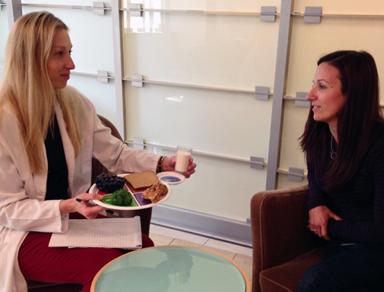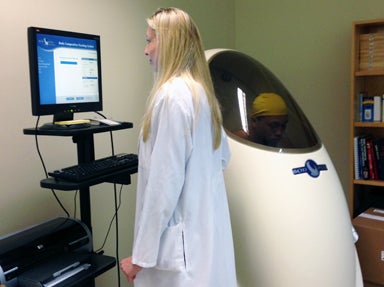 Left: FCS graduate student Simona Hradil talks with another student about the MyPlate portioning system for meals.
Left: FCS graduate student Simona Hradil talks with another student about the MyPlate portioning system for meals.
With the multitude of approaches to diet and nutrition all around us, tips and tricks for quick weight loss or fast muscle gain and claims of maximum fitness with minimal effort, science and common sense continually point to a simple fact: A nutrient rich diet and regular exercise are the keys to fitness and well being. It’s easy to think an athlete at peak performance is the model of self discipline and sound nutrition practices, but that’s not always the case. Maybe athletes can get away with a few more cheats than the average couch potato, but when it comes down to it, nutrition, rest and appropriate levels of exercise all come into play for the short term performance, as well as the long term health, of the athlete. Athletes need coaching for nutrition, too.
Simona Hradil is working on her Master’s Degree in Nutrition Dietetics and Food Science in the Department of Family and Consumer Sciences. She is also a steady presence in the lives of several CSUN Athletic teams as a Nutrition Counselor keeping players on track for optimal performance and overall wellness throughout the year.
She knows the athlete can sometimes be tempted to take shortcuts to gain, maintain or lose weight for competitions, and she knows first hand how important it is to manage body fat, muscle mass and metabolism using sound principles. Hradil has practiced Taekwondo for 20 years, has competed for the US National Taekwondo Team for 12 years, and was an alternate for the 2012 Olympics in London. She currently competes for the Czech Republic.
When she came to California to train in 2004, Hradil also knew that to stay in her fighting weight class she would have to keep her level of body fat down. She wanted to do it in a healthy way, so she decided to be as thorough as possible and get her Master’s Degree in Nutrition. “I wanted to give back to the sport, and the weight constriction issue can really negatively affect competitors,” Hradil said. “You see them wearing sauna suits, overtraining, starving, and even though it’s not healthy some people think they have no choice if they want to compete.”
Hradil is studying with her mentor, Terri Lisagor, faculty and Acting chair of the department. Lisagor’s approach builds on the Peer Nutrition Counseling program already established at CSUN through the academic department in collaboration with the Marilyn Magaram Center for Food Science, Nutrition and Dietetics.
Peer Nutrition Counselors (PNC’s) provide services to other students through the Student Health Center and the Living Well Lounge at the Student Recreation Center. Lisagor explained, “We have 26 student counselors each required to do four hours of counseling a week. Any student can call, make appointment or book online,” she said. “We use ‘Choose MyPlate’ to teach portion balance and how to get the complete nutritional package with each meal. The PNC’s also visit University 100 classes to spread the word and find out what kinds of help students are asking for.”
The teams of PNC’s are available to athletes and all students on campus, and the success of this program generated the proposal for a grant to bring this keen nutritional focus to athletes. The grant, funded through the CSUN Campus Quality Fee, has placed Hradil in the position to help five CSUN athletics teams. Through referrals from Assistant Athletic Director for Sports Medicine, Steven Grech, Hradil counsels players from the Men’s Basketball team as well as Women’s Basketball, Tennis, Water Polo and Softball teams. She counsels one-on-one and reviews results with the coaches, working together for the benefit of the student athlete. Students get nutritional counseling as well as assessments throughout the year.
“Assessment includes dietary analysis,” Hradil explained. “At the beginning of the year, we have the athletes keep a three day food recall journal and we look at all elements of the diet, breaking down the components to macro and micro nutrients. Then when we counsel, recommending nutritional adjustments for top performance in peak season, and appropriate calorie intake during the off season.”

Also assessed, three times per academic year, is body composition. Rather than focusing strictly on weight, measurements are made using the equipment that is the gold standard for body composition analysis, the Bod Pod, at the Magaram Center, a common collaborator with the academic department.
“The Bod Pod is a favorite in the medical field because it can be used with patients who are elderly, or have pressure sensitivity, don’t want to be immersed in water, have a stint from a heart procedure or other complications,” Hradil said. “The Bod Pod is as accurate, if not slightly more so, than the hydrostatic method. But the Bod Pod is so much easier.”
Hydrostatic weighing requires the subject to be completely immersed in water, forcing as much air as possible out of the lungs and holding it. Both the Bod Pod and hydrostatic weighing account for residual lung volume and the weight of the organs, but water immersion is complicated, and the Bod Pod is a breeze. “The Bod Pod displaces air and the pressure change in the inner chambers is virtually undetectable by the subject,” Hradil said.
And in the day to day of team interaction from the Athletics side, she is driving home the importance of nutrition for the game, for focus, staying healthy and avoiding injury. “Working together, we’re developing a culture,” Hradil said, “We’re making sure the student athletes get the full benefit of the program.”
“The athletes have been amazing to work with,” Hradil added. “I am impressed with everyone's work ethic, as they are driven to make the necessary changes to improve their performance. The fact that I’m a competing athlete, too, makes it easier for the athletes to believe I know what I’m talking about,” she said. “I’d love to see more of this – nutritionists dedicated to the CSUN Athletics teams.”
-Jean O'Sullivan
SP2014
